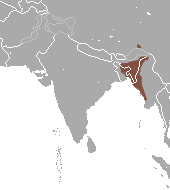Western hoolock gibbon
| Western hoolock gibbon | |
|---|---|
 |
|
| A female in the foreground, and a male in the background | |
| Scientific classification | |
| Kingdom: | |
| Phylum: | |
| Class: | |
| Order: | |
| Family: | |
| Genus: | |
| Species: |
H. hoolock
|
| Binomial name | |
| Hoolock hoolock (Harlan, 1834)
|
|
 |
|
| Western hoolock gibbon range | |
Lua error in Module:Taxonbar/candidate at line 22: attempt to index field 'wikibase' (a nil value).
The western hoolock gibbon (Hoolock hoolock) is a primate from the gibbon family, Hylobatidae. The species is found in Assam, Bangladesh and in Myanmar west of the Chindwin River.[2]
Classification
Mootnick and Groves[3] stated that hoolock gibbons do not belong in the genus Bunopithecus, and placed them in a new genus, Hoolock. This genus was argued to contain two distinct species which were previously thought to be subspecies: Hoolock hoolock and Hoolock leuconedys which were later have found that the 2 species have a bigger difference to that of white handed gibbons than bonobos to chimpanzees.[4]
Habitat
In India and Bangladesh it is found where there is contiguous canopy, broad-leaved, wet evergreen and semi-evergreen forests dipterocarpus forest often mountainous. The species is an important seed disperser; its diet includes mostly ripe fruits, with some flowers, leaves and shoots.[citation needed]
Conservation
There are numerous threats to western hoolock gibbons in the wild, and are now entirely dependent on human action for their survival. Threats include habitat encroachment by humans, forest clearance for tea cultivation, the practice of jhuming (slash-and-burn cultivation), hunting for food and “medicine”, capture for trade, and forest degradation.[1]
Over the last 30–40 years, western hoolock gibbon numbers are estimated to have dropped from more than 100,000 (Assam alone was estimated to have around 80,000 in the early 1970s) to less than 5,000 individuals (a decline of more than 90%).[5] In 2009 it was considered to be one of the 25 most endangered primates,[6] though it has been dropped from the later editions of the list. [7]
Diet
Hoolock gibbons feed mostly on various fruits, with some leaves, flowers and insects.[citation needed]
See also
References
- ↑ 1.0 1.1 Brockelman, W., Molur, S. & Geissmann, T. (2008). Hoolock hoolock. In: IUCN 2008. IUCN Red List of Threatened Species. Retrieved 4 January 2009.
- ↑ Lua error in package.lua at line 80: module 'strict' not found.
- ↑ Lua error in package.lua at line 80: module 'strict' not found.
- ↑ Lua error in package.lua at line 80: module 'strict' not found.
- ↑ Lua error in package.lua at line 80: module 'strict' not found.
- ↑ Lua error in package.lua at line 80: module 'strict' not found.
- ↑ Lua error in package.lua at line 80: module 'strict' not found.
